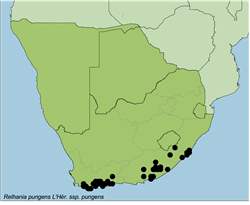Names and synonyms
Relhania pungens L'Heritier ssp. pungens =Eclopes subpungens Cass., nom. superfl.=Eclopes pungens DC., sphalm. (= Eclopes subpungens Cass.)=Relhania trinervis Thunberg =Eclopes trinervis (Thunb.) Less. (excl. descr. = R. calycina (L.f.) L'Herit. ssp. calycina)=Eclopes acicularis Cassini =Relhania acicularis Desf. ex Cass., pro syn.=Eclopes subpungens Cass. var �. acicularis (Cass.) DC. =Eclopes parallelinervis Lessing =Eclopes parallelinervis Less. var. �. angustifolia DC. =Relhania pungens L'H�r. p.p.
Derivation of names
Relhania = after Irish-born Richard Relhan (1754-1823), botanist, plant collector, bryologist, lichenologist, one of the founders of the Linnean Society, rector in Lincolnshire and author of Flora Cantabile.pungens = with sharp points, piercing
Diagnostic characters
Leaves quite variable from fine and soft to more rigid and robust
Description
A sparsely branched shrublet or suffrutex, 0.3-0.5 m tall, with a woody rootstock. Stems ascending-erect, tomentose, leafy, becoming glabrous and nude and marked with leaf-scars. Leaves 8-25 x 0.5-5 mm, usually linear or sometimes lanceolate or narrowly elliptic, coriaceous and sometimes somewhat rigid, distinctly 3-9-nerved with closely parallel to widely spaced nerves, usually tomentose with deciduous indumentum or occasionally glabrous dorsally, densely lanate and whitish above, acute, often pungent. Capitula solitary, sessile, terminal. Involucre 6-18 mm wide, bell-shaped. Involucral bracts 25-60, outer ovate, inner gradually longer with a spreading apical limb, glabrous or dorsally tomentose and whitish. Receptacle flat-convex, paleate. Paleae canaliculate, subulate, entire or slightly and irregularly serrate, 5.5-10 x 0.4-0.8 mm, acute-acuminate, persistent. Ray florets 15-30, tube somewhat triquetrous, 2.5-5 mm long, lamina narrowly elliptic-oblong, 6.5-14 x 1.5-2.7 mm, 4- or occasionally 5-6-veined. Disc florets 25-100, perfect. Pappus crownlike, of � connate scales, up to 1.9 mm long. Cypsela flat with inner edge often winged, elliptic-oblong-oblong, 1.9-3.5 x 0.6-1.2 mm wide, glabrous or shortly hispid-pilose with longer hairs on lateral ribs
Flowering time
From October, but mainly from December to February.
Distribution
R. pungens occupies a extended area from the southwestern Cape to the middle of KwaZulu-Natal. Ssp. pungens has a disjunct distribution. It occurs in the southwestern Cape mainly in Bredasdorp and south of Langeberg as far east as George and reappears in the eastern Cape from Port Elizabeth further north around Grahamstown, Fort Beaufort and Queenstown. Known from more than 80 specimens.
Habitat
Grows in a wide range of habitats, in fynbos and grassland on stony, rocky, sandy or clayey soil on flats and lower mountain slopes.
Notes
This is a variable species, composed of three subspecies, which look quite different from each other. Their leaves have many nerves and are always densely lanate above, which distinguish them from R. calycina and R. speciosa.The shape and venation of the leaves are the most important varying characters. Others are the shape of the involucral bracts and the size of the capitula with the floral parts. Although three subspecies are distinguished, the boundaries between them are not exactly defined and there will be specimens that are difficult to place.
Key to the subspecies 1a Leaves linear -lanceolate, with closely parallel nerves; the nerves not separated more than the width of the nerves themselves ......................................................................... 21b Leaves narrowly elliptic, with widely spaced nerves; the nerves separated more than the width of the nerves themselves ............................................................................ ssp. trinervis 2a Leaves hard and rigid, pungent, usually glabrous dorsally............................... ssp. pungens 2b Leaves � soft, acute, but not pungent, usually tomentose with deciduous indumentums dorsally ................................................................................................................. ssp. angustifolia
References
BREMER, K. 1976. The genus Relhania (Compositae). Opera Botanica 40. GLEN, H.F. 2004. SAPPI, What's in a Name? The Meanings of the Botanical Names of Trees. Jacana.KESTING, D. & CLARKE, H. 2008. Botanical names, what they mean. Wild Flowers of the Cape Peninsula, 3rd revised edition. Friends of Silvermine.POOLEY, E. 2005. A Field Guide to Wild Flowers, Kwazulu-Natal and the Eastern Region. Natal Flora Publications Trust.

_sml.jpg)